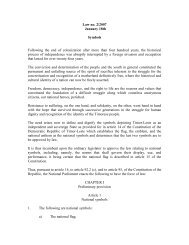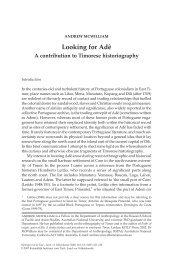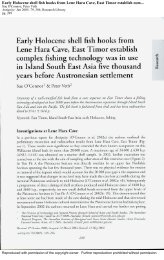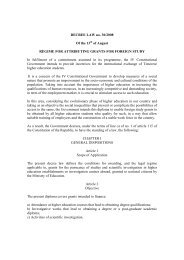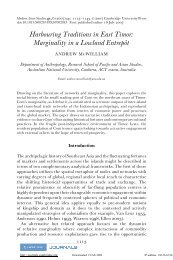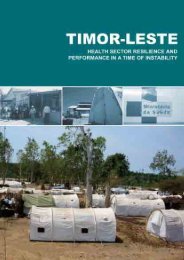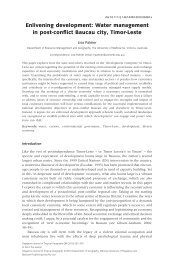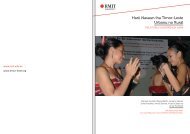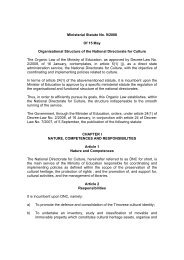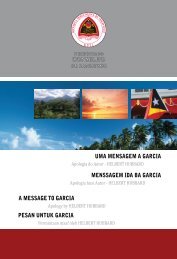Local Governance in Timor-Leste - Secretaria de Estado da Arte e ...
Local Governance in Timor-Leste - Secretaria de Estado da Arte e ...
Local Governance in Timor-Leste - Secretaria de Estado da Arte e ...
- No tags were found...
Create successful ePaper yourself
Turn your PDF publications into a flip-book with our unique Google optimized e-Paper software.
and constra<strong>in</strong> people's lives (L<strong>in</strong>klater, 1996: 279, Cox, 1981: 97-9). It is bestun<strong>de</strong>rstood through Cox's dist<strong>in</strong>ction between problem solv<strong>in</strong>g theory and criticaltheory, where problem-solv<strong>in</strong>g theory, draw<strong>in</strong>g on structuralist un<strong>de</strong>rstand<strong>in</strong>gs of<strong>in</strong>stitutionalism, takes exist<strong>in</strong>g structures as the framework for research, but criticaltheory "calls them <strong>in</strong>to question by concern<strong>in</strong>g itself with their orig<strong>in</strong>s and how andwhether they might be <strong>in</strong> the process of chang<strong>in</strong>g" (1981: 129). Accord<strong>in</strong>g to thecritical theorist, exist<strong>in</strong>g power structures cannot be taken for granted but must beconsi<strong>de</strong>red <strong>in</strong> their historical context, analysed <strong>in</strong> terms of who they <strong>in</strong>clu<strong>de</strong> an<strong>de</strong>xclu<strong>de</strong>, and viewed <strong>in</strong> terms of whether and how they might be chang<strong>in</strong>g (Cox 1981;K<strong>in</strong>cheloe and McLaren 2003; L<strong>in</strong>klater 2003). Un<strong>de</strong>rly<strong>in</strong>g critical theory is itsdialectic approach—the epistemological stance that reason and reality are <strong>in</strong>timatelytied to each other. The emancipatory role of critical theory is to br<strong>in</strong>g to the surfacethis constant back and forth between theory and material reality (How, 2003: 3-4).This study takes a critical theory approach for two reasons. First, viewed from with<strong>in</strong>a community, traditional <strong>in</strong>stitutional structures are regar<strong>de</strong>d as equally formal <strong>in</strong>quality to mo<strong>de</strong>rn <strong>in</strong>stitutional structures, and are <strong>in</strong>tegral to guid<strong>in</strong>g and shap<strong>in</strong>gcommunal life (Hohe, 2002a, Hohe and Nixon, 2003, Osp<strong>in</strong>a and Hohe, 2001). Fromthis perspective, the relative strength and weakness of mo<strong>de</strong>rn and traditional<strong>in</strong>stitutions cannot simply be taken for granted. As critical theory comes from theun<strong>de</strong>rstand<strong>in</strong>g that even those <strong>in</strong>stitutions or structures that are most embed<strong>de</strong>d with<strong>in</strong>a society are not natural or given (Cox, 1981: 129), it provi<strong>de</strong>s a useful frameworkthrough which to analyse the impact that these <strong>in</strong>stitutional structures have <strong>in</strong> shap<strong>in</strong>gcommunal relations.Second, critical theory provi<strong>de</strong>s a framework through which to exam<strong>in</strong>e not only thecoexistence of mo<strong>de</strong>rn and traditional structures but also to contextualise them with<strong>in</strong>the broa<strong>de</strong>r power relations of a <strong>Timor</strong>ese village. As K<strong>in</strong>cheloe and McLaren (2003:440) note, the i<strong>de</strong>ologies that un<strong>de</strong>rp<strong>in</strong> the hegemonic 'naturalisation' of powerrelations with<strong>in</strong> a community are always contested by various groups with differentagen<strong>da</strong>s. Critical theory provi<strong>de</strong>s a framework through which to conceptualise theclose <strong>in</strong>terrelationship between i<strong>de</strong>as, <strong>in</strong>stitutions and material capabilities that is partof the ongo<strong>in</strong>g process of <strong>in</strong>stitutionalisation (K<strong>in</strong>cheloe and McLaren, 2003: 471,Cox, 1981: 140). By tak<strong>in</strong>g a critical approach, we can beg<strong>in</strong> to <strong>in</strong>terrogate the31



